
Pondicherry Travel Guide – Explore French Charm, Beaches & Auroville
Your snapshot of Pondicherry’s French lanes, beaches, and Auroville’s serenity.
Updated on: 15th, Nov 2025
Explored on: Nov' 2023
Pondicherry: Where India Meets France by the Sea
If you love the sea, sunshine, and slow mornings, Pondicherry is that quiet coastal dream that wins you over without trying. Often called the French Riviera of the East, this seaside town blends Indian soul with French charm, creating a postcard at every turn.
Once a humble fishing village named Putucerri—meaning new village in Tamil—this place was shaped by the French in the 17th century into the vibrant port town we know today. Though officially renamed Puducherry in 2006, most travelers still lovingly call it Pondy—a name as breezy as its beaches.
As you wander through the French colony of Pondicherry, you’ll pass pastel streets lined with bougainvillea, colonial villas with louvered doors, art cafés playing soft jazz, and quiet churches facing the sea. The heritage architecture, the aroma of baked croissants, and the golden light of coastal mornings all whisper the same story—of a place where time moves slowly and beautifully.
Pondicherry travel isn’t about rushing through checklists. It’s about letting go. From sunrise walks along the Promenade Beach to peaceful sunsets at Paradise Beach, and evenings spent in cozy cafés at White Town, Pondicherry makes you pause, breathe, and simply be.
Table of Contents
How to Reach Pondicherry – Your Journey to the French Coast of India
Getting to Pondicherry is as calm and charming as the town itself. Whether you fly, drive, or take the train, every route offers a little piece of the journey’s magic.
By Air:
The nearest major airport is Chennai International Airport, about 150 km from Pondicherry. From there, a scenic three-hour drive along the East Coast Road (ECR) takes you right to the coast. This route is a traveler’s favorite — smooth roads, glimpses of the Bay of Bengal, and coastal villages that appear and disappear like daydreams. You can hire a cab, catch a bus, or even rent a bike from Chennai if you’re in the mood for a bit of adventure.
By Train:
Pondicherry Railway Station connects the town to a few major cities, including Chennai, Villupuram, and Tirupati. If you’re traveling from elsewhere, you can connect via Chennai or Villupuram Junction. The train journey may be slower, but as the Tamil countryside drifts by your window, you’ll understand why it’s worth it — it’s the kind of slowness that fits Pondicherry’s peaceful pace.
By Road:
For many travelers, the best way to reach Pondicherry is by road. The ECR drive from Chennai is easily one of India’s most beautiful coastal roads — the sea glitters on one side, while palm groves, salt pans, and fishing villages wave you through on the other. If you’re coming from Bangalore (310 km) or Trichy (200 km), smooth highways make for a comfortable journey too.
No matter how you arrive, reaching Pondicherry feels like a soft landing — from the hum of the cities into the hush of the sea. The road itself seems to slow you down, preparing you for the easy rhythm of Pondicherry life.
Best Time to Visit Pondicherry – When the Sea and Sky Feel Just Right
Pondicherry wears every season like a new mood — sometimes bright and breezy, sometimes calm and misty. Yet through it all, the town keeps its steady rhythm, inviting you to slow down and sink in.
Winter (October to March):
This is the best time to visit Pondicherry. The weather stays pleasant, with cool evenings and golden mornings perfect for beach walks or cycling through the French colony. Cafés hum with travelers, the sea breeze stays soft, and the whole town glows in that warm coastal light. Whether you’re exploring Promenade Beach, White Town, or Auroville’s serene paths, winter wraps everything in gentle joy.
Summer (April to June):
Pondicherry in summer can get hot and humid — temperatures sometimes touch 40°C. But this is also when Pondicherry slows down beautifully. With fewer crowds and lower prices, the town feels quieter and more personal. Plan your outings early morning or near sunset, and spend your afternoons in shaded cafés or charming heritage stays with ceiling fans humming and time standing still.
Monsoon (July to September):
Then comes the monsoon, painting Pondicherry in shades of green and silver. The air smells of rain and sea, the French streets gleam clean, and cafés turn into cozy hideaways. It’s the season for slow travel — reading by the window, sipping filter coffee, watching the drizzle soften the skyline.
Personally, I love Pondicherry just after the monsoon — when the skies clear, the bougainvillea blooms again, and the town sparkles under golden light. Whatever the season, Pondicherry never hurries; it simply waits for you to match its pace.
Where to Stay in Pondicherry – Sleep by the Sea, Dream in Color
Pondicherry may be small, but when it comes to places to stay, it overflows with character. From luxury hotels by the beach to heritage homes in White Town and colorful backpacker hostels, every corner of this coastal town has its own kind of comfort waiting for you.
Luxury Stays in Pondicherry:
If you’re here to unwind in style, Pondicherry’s luxury hotels blend French elegance with coastal calm — think colonial courtyards, sea views, and verandas that open to golden sunsets.
The Promenade – Overlooking the Bay of Bengal, perfect for sunset views and seaside strolls.
La Villa – A restored French-era mansion turned boutique hotel — elegant yet homely.
Palais de Mahe (CGH Earth) – Heritage luxury at its finest, radiating French colonial charm.
These are ideal if you want to pair your seaside escape with boutique comfort and top-notch hospitality.
Heritage Stays in White Town:
If you love history woven into your mornings, stay in one of Pondicherry’s heritage hotels — many are restored French villas tucked into White Town, where every wall tells a quiet story.
Le Dupleix – Once home to a French governor, now a beautifully restored heritage stay.
Maison Perumal – A Franco-Tamil house with graceful courtyards and soulful simplicity.
Villa Shanti – A blend of modern design and vintage vibes, loved for its lively café and warm charm.
These stays let you live inside Pondicherry’s past, wrapped in comfort and calm.
Mid-Range Hotels in Pondicherry:
For travelers who like balance — comfort without splurge — mid-range stays in Pondicherry offer style and ease.
Hotel De L’Orient – Classic, warm, and full of character, right in the heart of White Town.
Kadal – The Beach House – A serene coastal escape just outside the city buzz.
Hotel Atithi – Modern, family-friendly, and close to major attractions.
Perfect for short trips or weekend getaways, these hotels deliver both value and atmosphere.
Budget Stays & Backpacker Hostels:
For free-spirited travelers, Pondicherry’s backpacker hostels are full of color, laughter, and stories. Expect rooftop hangouts, open kitchens, and friends you haven’t met yet.
Zostel Pondicherry – The go-to hostel near the beach, social and spotless.
Micasa Hostels – Friendly, clean, and close to the Promenade Beach.
Auro Beach Guest House – Peaceful, affordable, and near both Auroville and the sea.
These stays are made for those who travel light and live fully — where conversations last longer than check-ins.
No matter where you stay, Pondicherry’s charm seeps through — in the pastel walls, the sea breeze, and the calm rhythm that makes you forget the clock. Here, every night’s stay feels like a page from your own travel story.


Sunrise paints the Promenade gold,
Waves whisper stories, soft and old.
French streets hum with pastel charm,
Temples, churches — peace in calm.
Cafés bloom with coffee scents,
Laughter drifts through quiet lanes.
Lush gardens breathe a leafy song,
Lighthouse views stretch wide and long.
Serenity Beach greets dawn’s first light,
Auroville shines in golden quiet.
Matrimandir glimmers, still and tall,
SVARAM echoes a gentle call.
Arikamedu whispers ruins and trade,
Mangroves sway, reflections displayed.
Paradise Beach glows as sun dips low,
Pondy’s soul in sunset’s glow.
Pondicherry isn’t a place you rush through — it’s a town that invites you to slow down, breathe in the sea breeze, and let the day flow at its own pace. But if you plan it right, two days in Pondicherry are just enough to explore its highlights and still hold onto its calm, coastal soul.
And if time allows, keep one extra day tucked in your pocket — for lazy breakfasts, aimless walks, and those golden evenings by the beach when Pondy feels like it’s standing still just for you.
This 2-day Pondicherry itinerary blends the best of both worlds — the French charm of the old town and the quiet beauty that lies just beyond it. Day 1 lets you wander through White Town, Promenade Beach, and the French Quarter cafés, soaking in the pastel calm and colonial grace. Day 2 takes you farther — to Auroville, Paradise Beach, and the peaceful outskirts where life slows to a whisper.
Whether you come for the heritage streets, the seaside sunsets, or the gentle rhythm of local life, this itinerary isn’t a checklist — it’s a compass. One that guides you through the best places to visit in Pondicherry, but still leaves space for wonder, detours, and that easy kind of joy that Pondy does best.
How to Spend 2 Days in Pondicherry - Beaches, Heritage & Beyond
Day 1 – Through White Town’s Lanes and Coastal Calm
Day one is all about soaking in the soul of Pondicherry — the calm streets, the sea breeze, and that quiet blend of French charm and Indian warmth. This is the day to wander through the pastel lanes of White Town, feel the old-world beauty tucked behind every blooming bougainvillea, and let the rhythm of the town guide you.
You’ll begin by the sea, where mornings are slow, golden, and full of promise — then drift into temples, churches, and cozy cafés that carry the spirit of Pondy in their walls. It’s a day of easy walks, gentle discoveries, and lingering moments — where you don’t just see Pondicherry, you feel it.
By the time the sun sets over Promenade Beach, you’ll understand why Pondicherry isn’t just a place to visit, but a mood to slip into — unhurried, graceful, and endlessly soothing.
Promenade Beach – Waves, Walks & Whispered Calm
Start your Pondicherry morning where the town truly wakes up — at Promenade Beach. Timing is everything here. Arrive early, just as the first light spills across the Bay of Bengal, and you’ll find the beach at its calmest — waves whispering against the rocks, locals out for a jog, and the air still cool with salt and quiet.
Also known as Rock Beach or Mahatma Gandhi Beach, this scenic stretch runs along Goubert Avenue in White Town, beginning near the French War Memorial and ending at the Dupleix Statue. It’s not a beach for swimming — it’s a long, stone-lined walkway by the sea, made for slow walks, reflection, and simple moments.
The beauty of Promenade Beach Pondicherry lies in its simplicity — the wide boulevard, the rhythmic sound of the waves, and the timeless energy that flows between colonial buildings and the open sea. It’s a favorite among photographers, wanderers, and anyone who loves watching the world wake up slowly.
As the day moves on, the promenade fills with families, street vendors, travelers, and children chasing waves. But whether you come at dawn or during a golden sunset, Promenade Beach never loses its charm. It’s the perfect start to your Pondicherry itinerary — calm, refreshing, and a soft reminder that the best moments often arrive when you’re in no hurry at all.
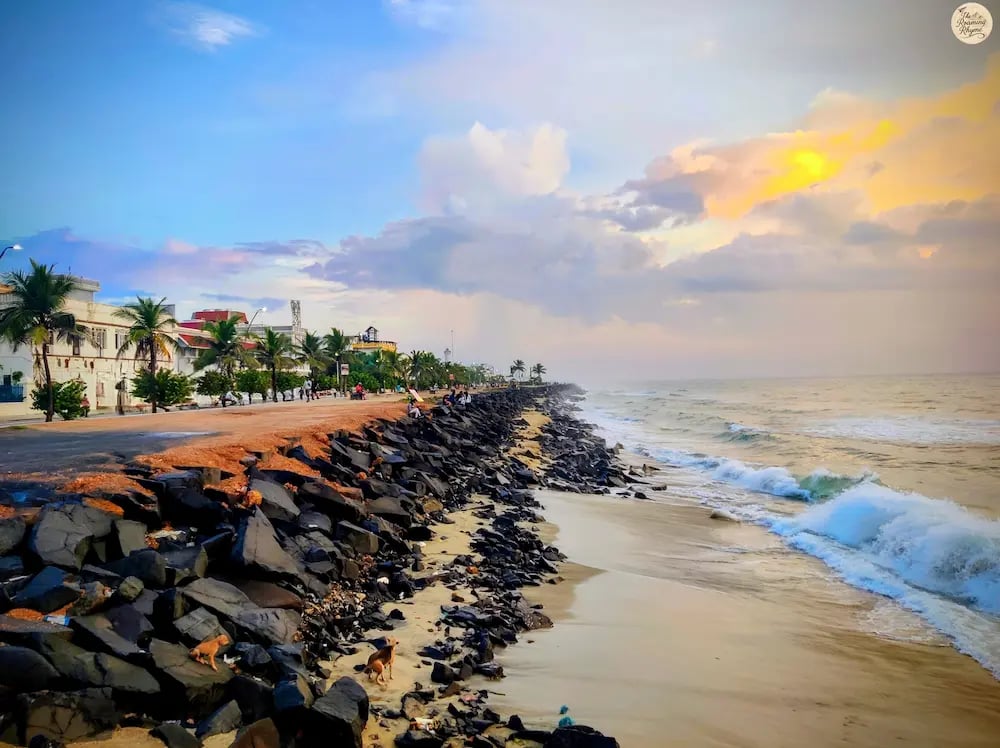


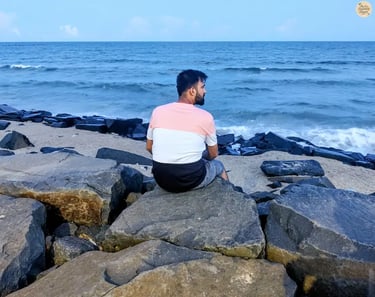
Morning calm on Pondy’s rocks
Early sunrise view at Pondicherry rock beach.
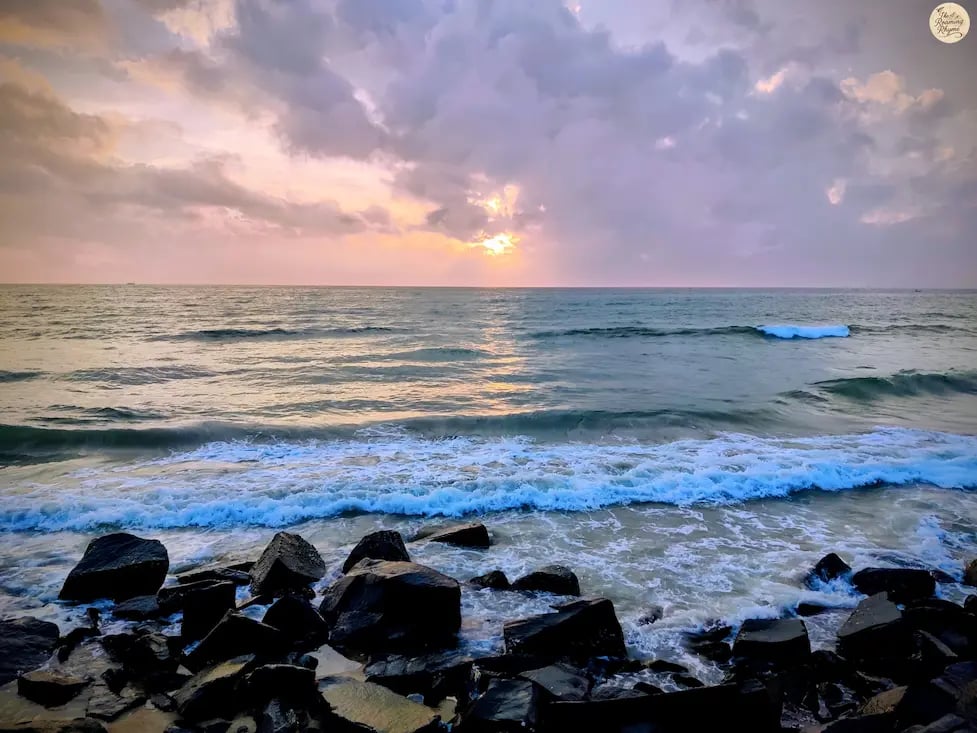

Sunrise whispers over Rock Beach
French War Memorial & Gandhi Statue – Colonial Echoes & Freedom’s Calm
As you stroll along Promenade Beach, two landmarks quietly remind you of Pondicherry’s layered history — the French War Memorial and the Gandhi Statue. Standing just a short walk apart, they bridge two worlds: one echoing the town’s French colonial past, and the other symbolizing India’s journey to freedom.
The French War Memorial Pondicherry, built in honor of soldiers who lost their lives during World War I, rises with white stone dignity and colonial grace. Visit early in the morning, when sunlight softens its edges and the sea breeze still feels untouched — it’s a moment of quiet reflection before the city fully wakes. Each year, on Bastille Day (July 14), the memorial becomes a place of remembrance, as Pondicherry pays tribute to its enduring connection with France.
A little further down the promenade stands the Gandhi Statue Pondicherry, one of the largest statues of Mahatma Gandhi in India. Surrounded by eight grand granite pillars brought from the historic Gingee Fort, the statue looks out over the sea with calm, watchful eyes — a timeless symbol of peace and simplicity meeting the rhythm of the waves.
Pausing at these two landmarks adds depth to your Pondicherry morning walk. Amid the sound of surf and the stirring city, they remind you that Pondicherry is more than its beauty — it’s also memory, history, and harmony between worlds that once stood apart.
Historic French War Memorial on Promenade
Iconic Mahatma Gandhi Statue on the beachfront in Pondy.
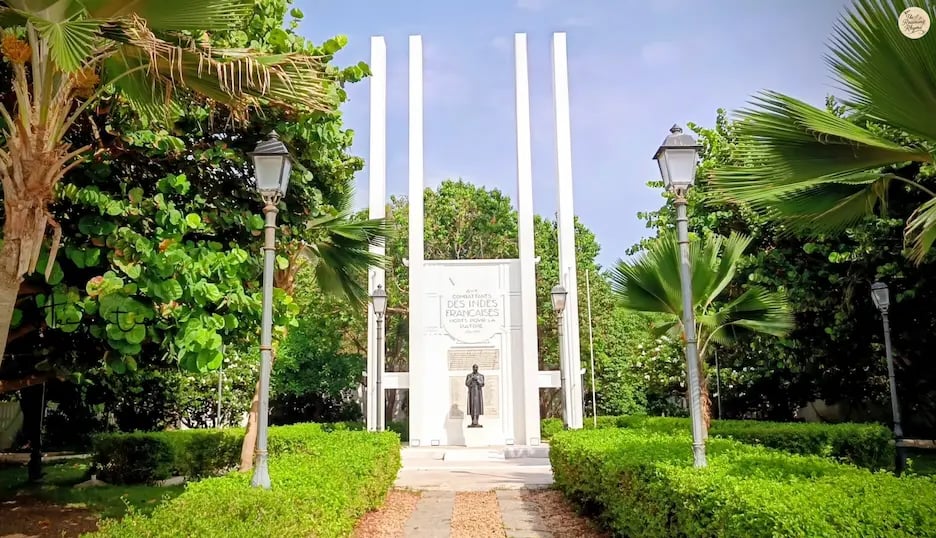

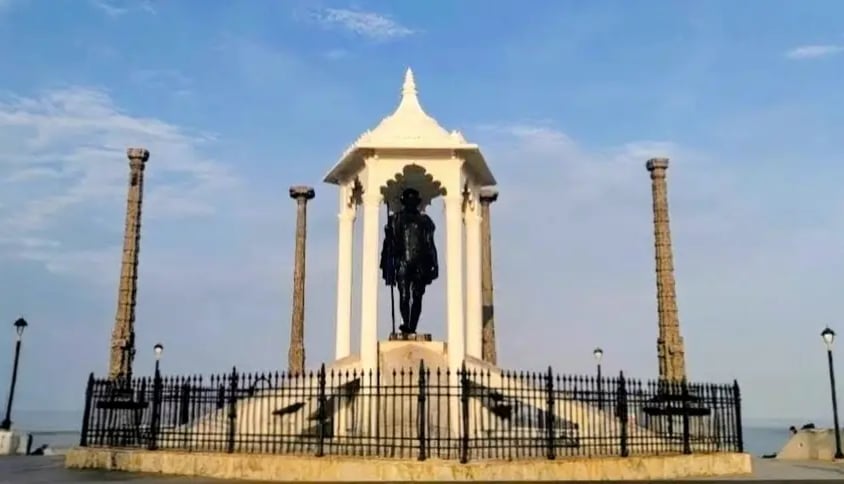

White Town Walk – Exploring Pondicherry’s French Charm
After soaking in the calm of Promenade Beach, step into the pastel world of White Town — Pondicherry’s French Quarter. Here, the city reveals its soul — in mustard-yellow walls, flowering balconies, and quiet lanes scented with sea breeze and freshly brewed coffee.
The best way to explore this area is simple: walk and wander. There’s no rush, no fixed route. The joy lies in getting lost among cobbled streets lined with colonial villas, art cafés, and centuries-old churches. Every corner feels like a frame — graceful, timeless, and deeply photogenic.
Start your morning at Café des Arts for breakfast — colorful, artsy, and full of life, with murals on the walls and vintage décor inside. The food is delicious, though a small heads-up: opening hours can be unpredictable. Once inside, the charm more than makes up for a little waiting.
From there, wander toward Rue Surcouf, where rows of mustard-yellow façades gleam in the sunlight, and bilingual street signs whisper stories of Pondicherry’s dual heritage. Not far away stands Villa Krish, a boutique hotel with a rooftop restaurant — dinner under its soft lights is unforgettable. Similarly, Palais de Mahé on Rue de Bussy dazzles with colonial elegance; its serene courtyard and pool invite a quick peek even if you’re not staying overnight.
A few steps further, you’ll find the Chambre de Commerce, set in a grand colonial building from 1849. It still functions today, and occasionally hosts art exhibitions, adding a contemporary touch to history.
As your stroll continues, the chime of distant church bells may lead you to the Church of Our Lady of Angels (Église de Notre Dame des Anges). This elegant cream-and-pink church, the fourth oldest in Puducherry, feels like a quiet piece of Europe by the sea. Step inside to feel the world soften — sunlight filters through arched windows, the air cools, and for a moment, all noise fades.
Further down Marine Street, the French Consulate rises, one of the city’s most photographed landmarks. Entry is restricted, but its pristine white façade is perfect for a postcard shot along your walk.
A stroll through the French Quarters Pondicherry isn’t about ticking off sights — it’s about feeling the town’s rhythm. The hum of scooters, the scent of jasmine and croissants, the sunlight on old shutters — everything moves at its own unhurried pace. As you drift through these lanes, you’ll find yourself slowing down, letting Pondicherry’s gentle rhythm guide you too.
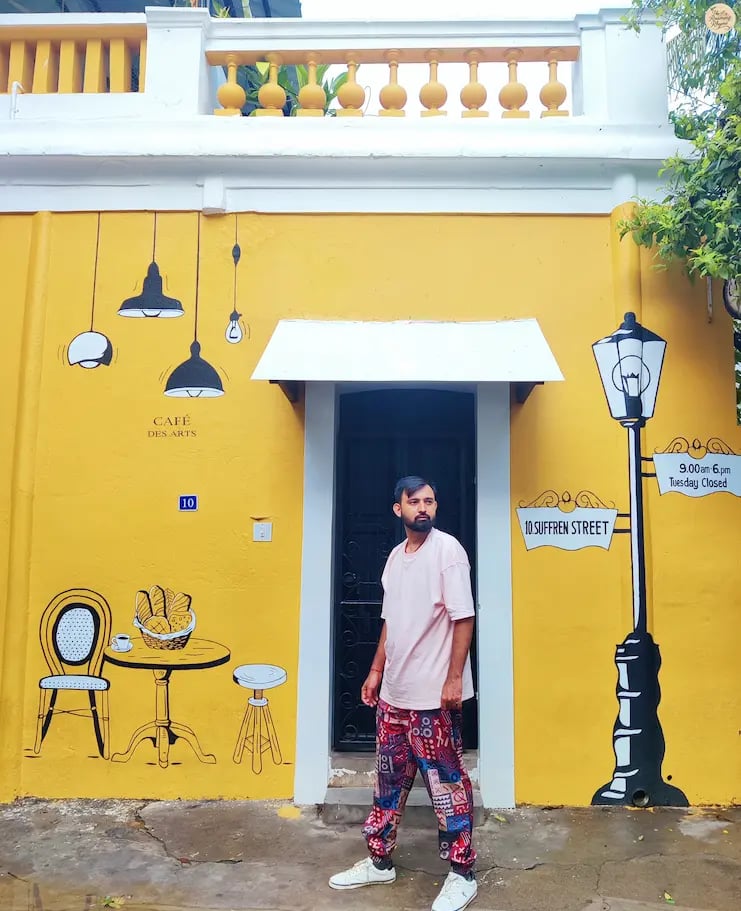


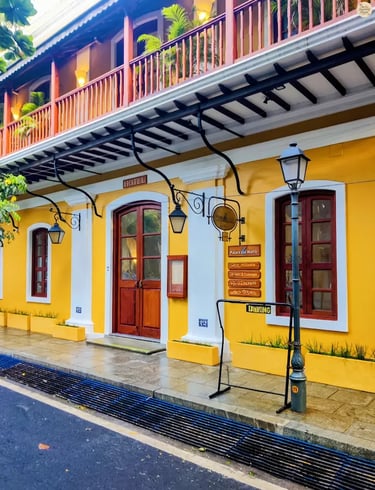
A mural that hums Pondy’s vibe.
A French escape in White Town.
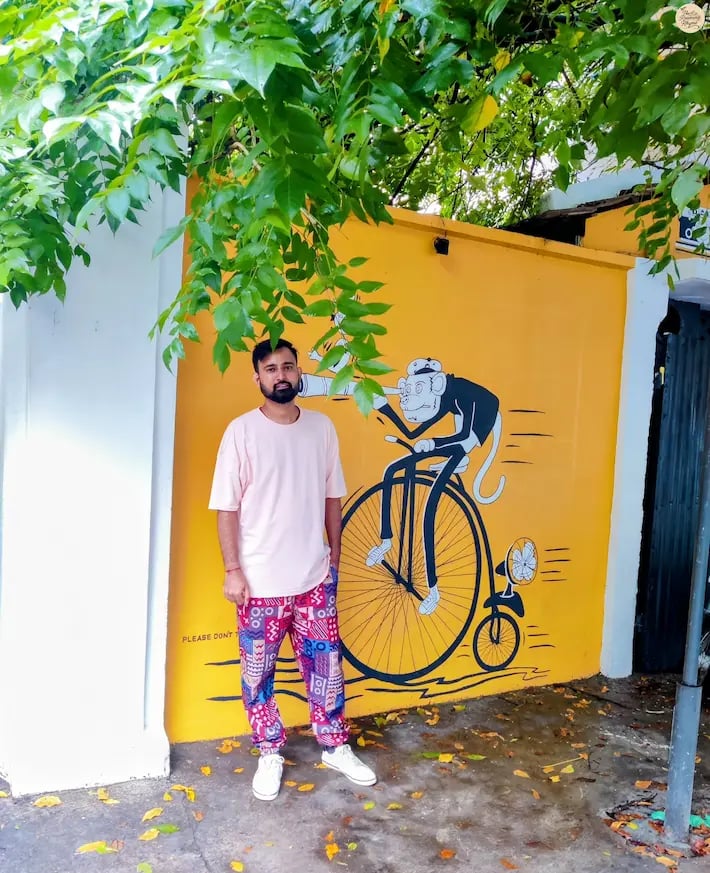

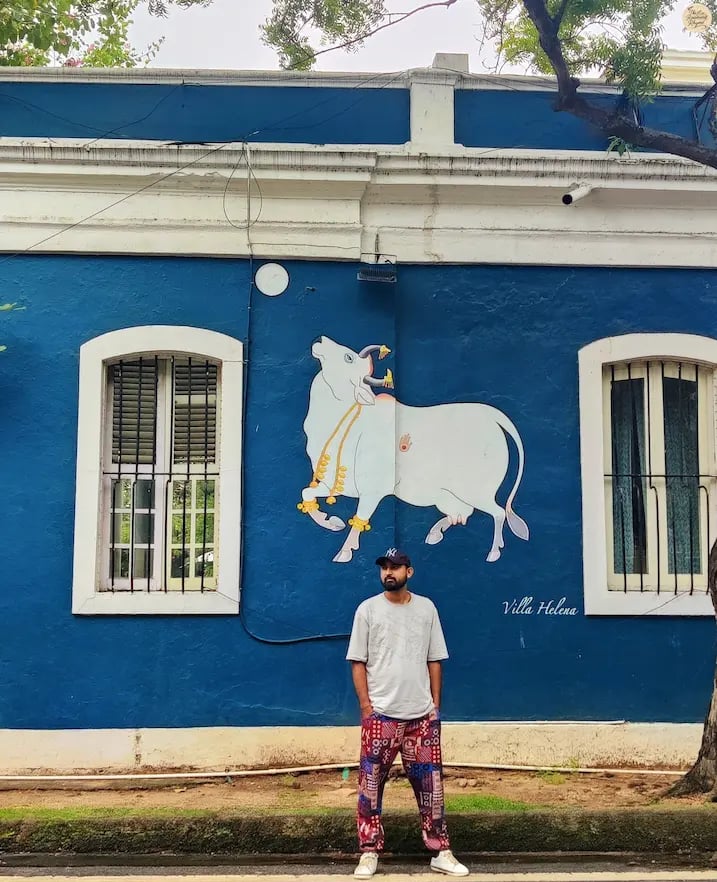

Where every lane feels like a postcard.
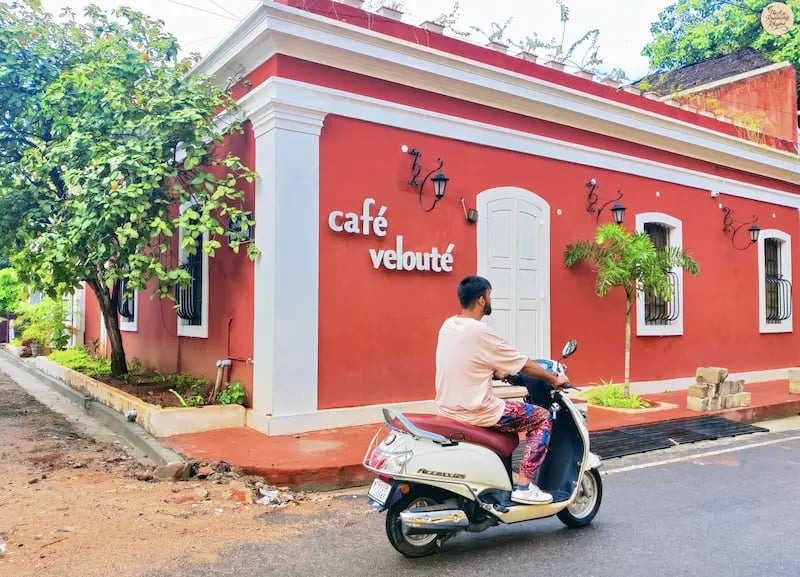

French café vibes in Pondy.
Sri Aurobindo Ashram – The Spiritual Heart of Pondicherry
After the lively stroll through White Town’s colorful lanes, step into a world of calm — the Sri Aurobindo Ashram Pondicherry. This isn’t just a place to visit; it’s a space to breathe. To slow down. To listen to the quiet inside you.
Founded in 1926 by Sri Aurobindo and The Mother (Mirra Alfassa), the Ashram stands at the heart of Pondicherry, radiating an energy that feels both still and alive. Here, spirituality isn’t distant — it’s woven into everyday life. You’ll see people reading in shaded corners, tending gardens, or sitting in deep silence near the Samadhi, the marble shrine holding the remains of Sri Aurobindo and The Mother. Even if meditation isn’t your usual practice, it’s hard not to feel a soft peace wash over you as you step inside.
The ashram’s roots trace back to Sri Aurobindo’s retreat from political life, turning inward to explore consciousness and self-growth. The Mother soon joined him, shaping a living community where spirituality and daily life intertwined. Over time, it has grown into a serene network of buildings, libraries, workshops, and gardens, all guided by the quiet purpose of inner evolution.
Unlike most ashrams, this one is vibrant yet tranquil — calm, but never static. Whether you come for a few minutes or linger longer, Sri Aurobindo Ashram leaves a sense of balance — a gentle reminder that peace isn’t something you find, it’s something you feel.
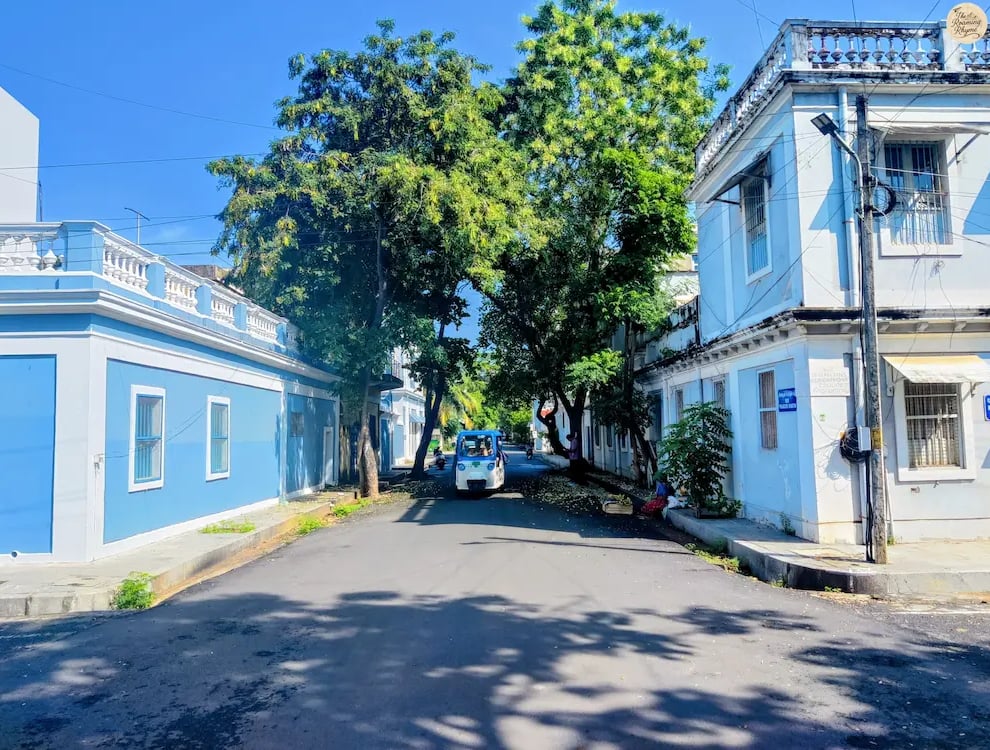

Quiet blue-hued streets surrounding Sri Aurobindo Ashram.

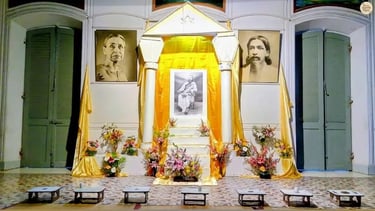
Portraits of Aurobindo and The Mother at Sri Aurobindo Ashram.
Calm French charm by the Aurbindo Ashram
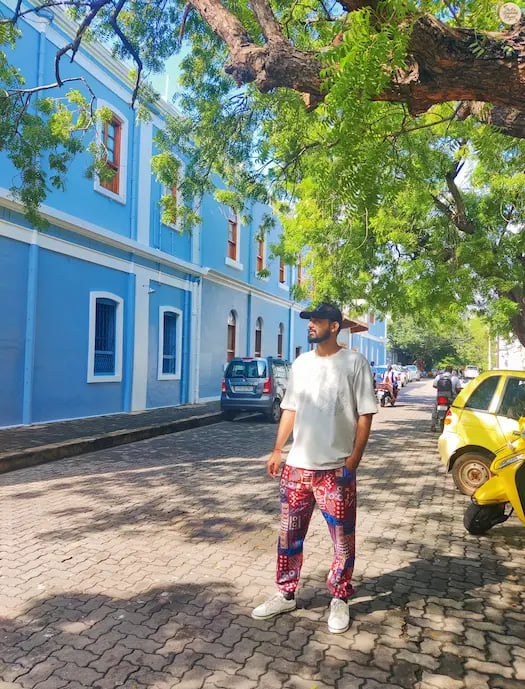

Arulmigu Manakula Vinayagar Temple – A Divine Pause
Just a short walk from the Sri Aurobindo Ashram lies one of Pondicherry’s most sacred landmarks — the Arulmigu Manakula Vinayagar Temple. Dedicated to Lord Ganesha, this centuries-old shrine radiates faith, color, and calm in equal measure.
Long before the French arrived — even before 1666 — this temple stood near the Bay of Bengal. In Tamil, “Manal” means sand and “Kulam” means pond, together describing its original setting beside a sandy pond — hence the name Manakula Vinayagar, or “Ganesha by the pond of sand.”
History has tested the temple’s resilience. When the French built a fort nearby in 1688, they tried to remove the idol, even casting it into the sea — yet legend says it reappeared each time. Eventually, the colonists gave up, and over time, the temple became a symbol of devotion and Tamil cultural pride, standing strong through centuries of change.
Architecturally, the temple is a feast for the eyes — vibrant Dravidian-style gopurams, colorful carvings, friezes, and intricate stucco figures glimmer under the southern sun. Inside, chants, bells, and the aroma of incense create a space that feels lively, spiritual, and timeless.
Don’t miss meeting Lakshmi, the Temple’s Gentle Resident Elephant, who blesses visitors with her trunk every evening — a simple, magical moment that leaves you smiling as you step back into the streets of Pondicherry.

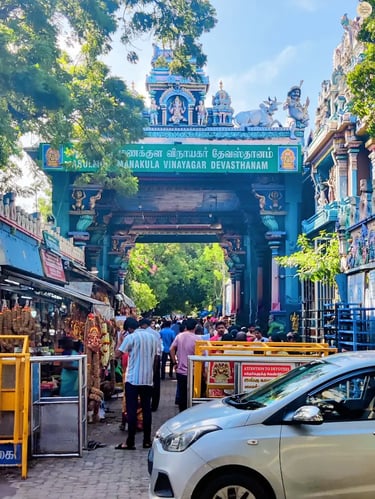
Manakula Vinayagar Temple, a sacred corner of old Pondy.
Immaculate Conception Cathedral – Pondicherry’s Sacred Classic
From the vibrant energy of Manakula Vinayagar Temple, take a short walk — and a gentle shift — into the serene world of the Immaculate Conception Cathedral, affectionately called Samba Kovil by locals. This 300-year-old masterpiece is the mother church of the Roman Catholic Archdiocese of Pondicherry and Cuddalore, and one of the city’s most elegant remnants of colonial faith.
Its pristine white and blue façade, touched with gold, reflects a graceful mix of French, Portuguese, and Herrian architectural styles. The first church was built in 1689 by French priests but was destroyed by the Dutch a year later. Over the centuries, it has been rebuilt multiple times, each version adding new layers of charm. The current structure stands on the foundation of the third reconstruction.
Inside, golden pillars line the central aisle, and the soft blue ceiling glows with scenes from the life of Jesus. Sunlight streams through stained-glass windows, painting gentle colors on the polished floor. You can sit on wooden benches, join a quiet prayer, or simply soak in the calm and stillness.
The cathedral once welcomed Mother Teresa, adding to its quiet grace. Whether you visit for faith, history, or the simple beauty of White Town Pondicherry, the Immaculate Conception Cathedral offers a gentle pause — a serene moment in the heart of the city.
Basilica of the Sacred Heart of Jesus - Pondicherry’s Divine Marvel
Standing tall on South Boulevard, the Basilica of the Sacred Heart of Jesus is one of Pondicherry’s most beautiful and sacred landmarks. Built by French missionaries in 1908, it was granted the status of a Basilica in 2011, making it one of only 21 in India.
The church’s Roman-Byzantine design with Gothic touches is a visual masterpiece. Its red-and-white façade, elegant Corinthian columns, and stained-glass windows create a scene that feels both grand and serene. Inside, soft sunlight filters through the colorful glass, filling the hall with a warm glow that invites quiet reflection.
Whether you come for faith, architecture, or simple peace, the Basilica of the Sacred Heart of Jesus Pondicherry leaves a gentle mark on your journey — a perfect blend of history, beauty, and calm in the heart of the city.

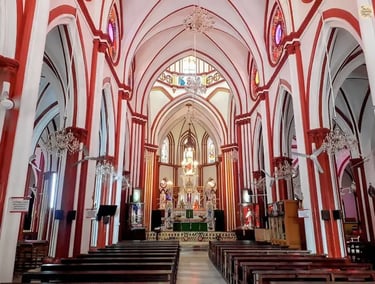
Interior of the Sacred Heart Basilica with stained-glass light.

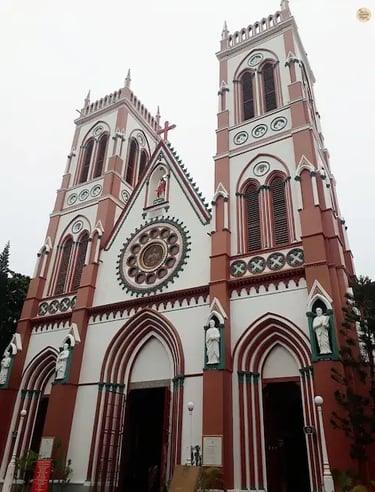
Exterior of the Sacred Heart Basilica with red-and-white Gothic design.
Botanical Garden Pondicherry – Colonial Roots, Natural Rhymes
Next, head to the Botanical Garden Pondicherry, located close to White Town — often called the lungs of Pondicherry for the fresh air it breathes into the city. Spread across 22 acres, this green oasis is perfect for a slow, peaceful walk among trees that are over a hundred years old.
Featured in the movie Life of Pi, the garden is home to more than 1,500 species of plants from around the world. Kids and adults alike enjoy the toy train ride, while the small aquarium with colorful tropical fish adds a playful touch.
It’s a calm, leafy escape — ideal for unwinding before you continue exploring Pondicherry’s attractions.
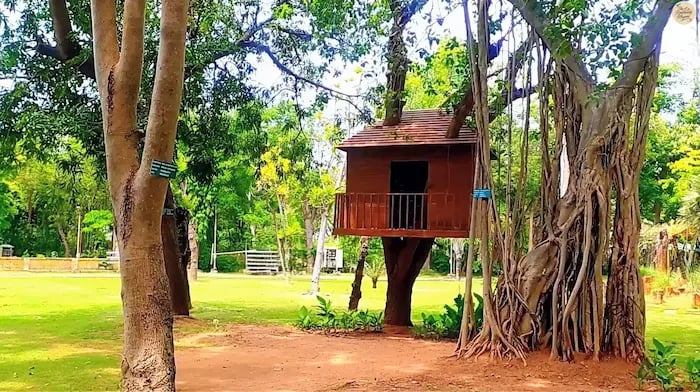

A tiny hideaway in the leaves.
Pondicherry Lighthouse – Guiding Lights Over the Bay
After a refreshing walk through the calm greenery of the Botanical Garden, make your way towards the coast for a view that stretches endlessly over the sea. The Pondicherry Lighthouse stands tall in Dubrayapet, about 2 km from White Town, where land meets horizon in a stunning sweep of blue.
Built in 1979, this 48-metre-tall black-and-white tower is Pondy’s New Lighthouse. The climb up its hexagonal staircase rewards you with a breathtaking panorama of the town and the Bay of Bengal. There’s no lift, so take it slow — every step is worth the view from the top.
Curious about its predecessor? The Old Lighthouse, near Promenade Beach by the Gandhi Statue, was built in 1836. At 29 metres, it once guided ships with twelve glowing oil lamps, their light visible for nearly 14 nautical miles along the Coromandel Coast.
Together, these two lighthouses — one historic, one modern — tell Pondicherry’s story, bridging changing times with timeless coastal views.
As the sun dips low and the sea breeze turns gentle, head back toward White Town or Promenade Beach to soak in Pondy’s easygoing evenings. The streets glow under soft yellow lights, cafés hum with quiet chatter, and the air feels lighter somehow — as if time itself has slowed down.
Settle in for dinner at a sea-view café or one of the heritage boutiques tucked inside old French houses. Order something comforting — perhaps crepes or grilled seafood — and let the sound of the waves play the perfect background music.
Nights in Pondicherry are calm yet full of soul — ideal for a slow walk by the shore before returning to your stay. Rest well, because Day 2 takes you beyond the town — to Auroville’s peaceful aura and Paradise Beach’s soft sands, where Pondicherry’s spirit gently unfolds a little further.
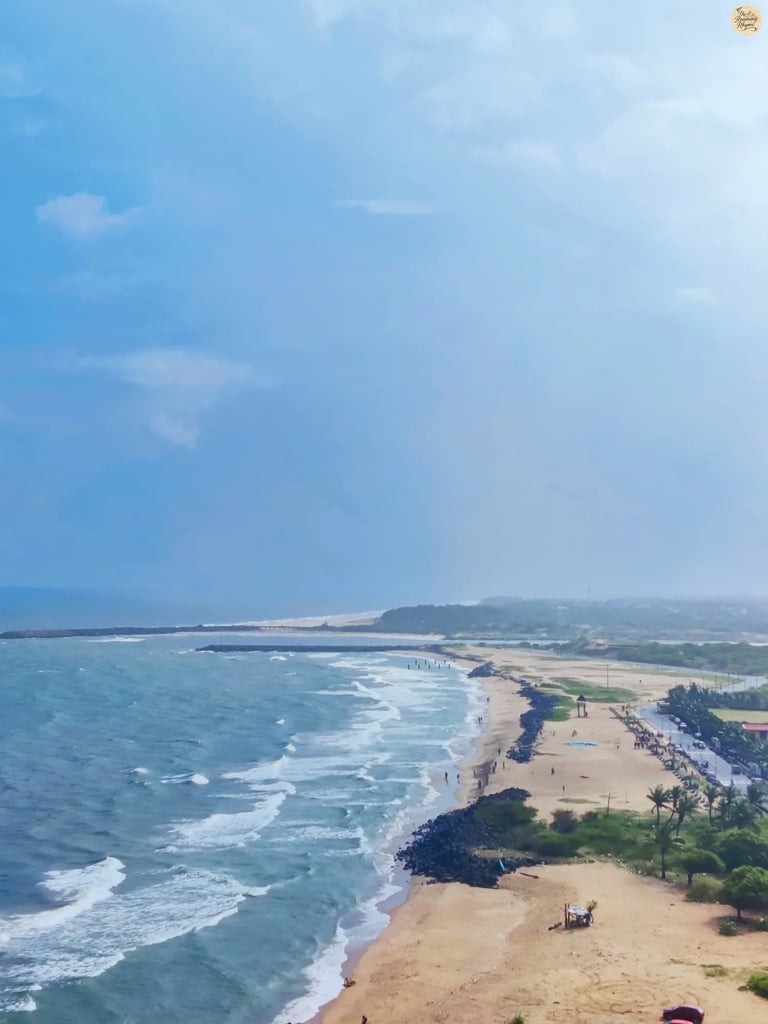


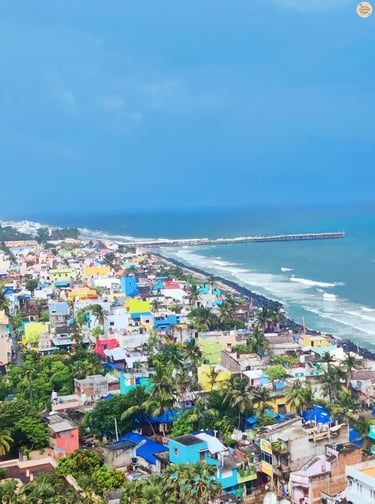
Waves, wind, and wide views.
Pondicherry unfolding from above.
Day 2 – Exploring Pondicherry’s Peaceful Outskirts
Step out of the bustling streets and into Pondy’s peaceful outskirts. Today is about slowing down — feeling the calm of Auroville, exploring the ancient charm of Arikamedu, gliding through Pondy Mangroves on a kayak, and ending the day with a leisurely stroll at Paradise Beach. It’s a perfect blend of nature, history, and quiet seaside magic, showing another, softer side of Pondicherry.
Serenity Beach – Surf, Sand, and Stillness
Begin your second day with the soft glow of dawn at Serenity Beach — the name says it all. Just 5 km north of White Town, this calm stretch in Kottakuppam is where Pondy greets the sun with quiet grace. As gentle waves roll and fishing boats rest along the shore, the world feels unhurried — just sea, sky, and stillness.
This beach is a favorite for surfing, with schools like Kallialay Surf School, Mother Ocean Surf School, and Guru Surf School offering lessons for beginners and pros alike. The waves are friendly yet exciting — perfect for anyone hoping to catch their first ride.
After a surf session or sunrise stroll, unwind at one of the casual cafés or seafood shacks nearby. With white sands on one side and rocky stretches on the other, Serenity Beach Pondicherry is exactly what its name promises — peaceful, picturesque, and the perfect start to your Pondy day.
Serenity Beach shoreline with soft white sand.
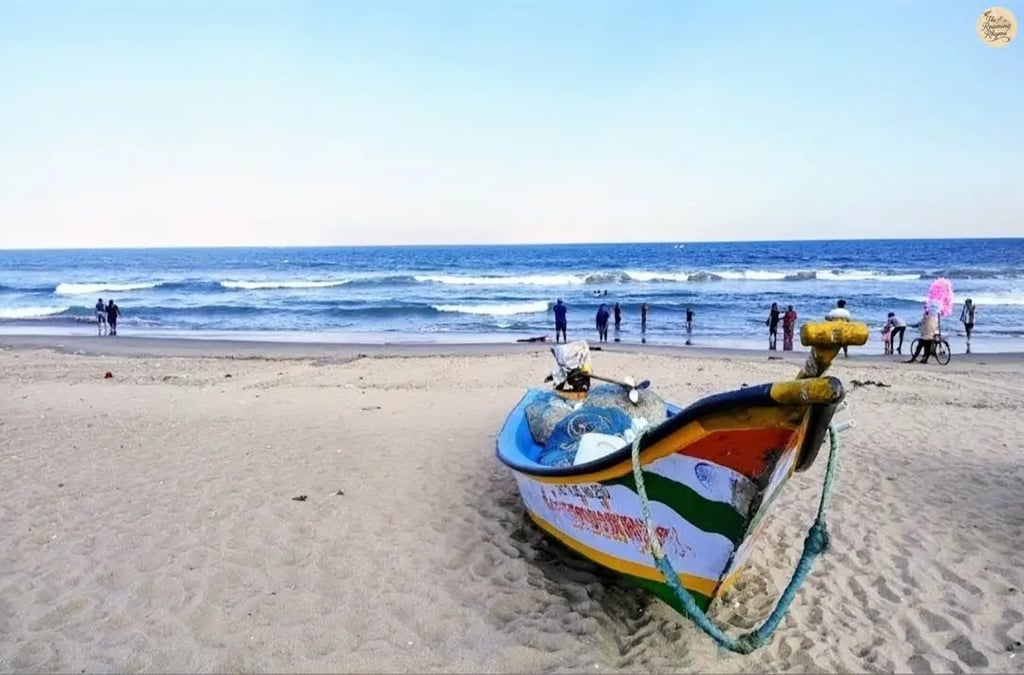



Surf lesson at Serenity Beach.
Auroville – Where the World Lives as One
Next, head toward Auroville, a place that feels less like a destination and more like an idea brought to life. Founded in 1968 by Mirra Alfassa, lovingly called The Mother, this “City of Dawn” was envisioned as a community where people from all nations live together in peace — beyond the lines of religion, politics, and nationality.
Inspired by the philosophy of Sri Aurobindo, Auroville Pondicherry stands as a living experiment in human unity and sustainable living. Calm, green, and deeply reflective, it’s a place where silence carries meaning. The golden globe of the Matrimandir, rising from the heart of Auroville, symbolizes spiritual awakening and is open only to those seeking quiet meditation.
Even if you don’t visit the inner township (which requires prior permission), the surrounding area has plenty to explore — charming cafés, art studios, organic farms, and boutiques that echo Auroville’s creative spirit.
A visit here is less about ticking sights off a list and more about slowing down — observing, breathing, and feeling quietly part of something larger than yourself.
Visit the Matrimandir
At the heart of Auroville stands the Matrimandir, often called the “Soul of the City.” Meaning “Temple of The Mother”, this golden sphere isn’t a place of worship but a space for quiet concentration and inner reflection. It embodies Auroville’s essence — a journey inward toward peace and self-awareness through integral yoga.
Located at the center of the township, the Matrimandir gleams under the sun, surrounded by lush gardens that enhance its serene atmosphere. Visitors can view it from a dedicated viewing point, accessible with a free pass from the Auroville Visitor’s Centre.
While the inner chamber is reserved for Aurovillians and those with prior permission, the viewing area offers a wonderful vantage to admire the structure’s radiant design and tranquil setting. Standing there, watching the golden sphere glisten amid greenery, you can’t help but feel a quiet sense of awe — as if time itself has gently paused.

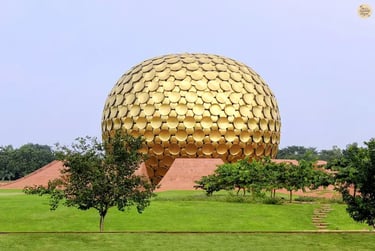
Matrimandir — gold gleaming in quiet green.
SVARAM Sound Garden
While the Matrimandir may be the heart of Auroville, the SVARAM Sound Garden is its rhythm — a space where sound, art, and healing come together. Often missed by visitors, SVARAM is one of Auroville’s most creative and fascinating corners. Recognized by the UN initiative “Music as a Global Resource” as one of the first 50 projects worldwide, it celebrates the universal language of sound.
Here, music isn’t just played — it’s discovered. Instruments handcrafted from natural materials are tuned to soothing frequencies that invite calm and curiosity. You’ll hear sounds from unexpected objects — chimes, strings, and resonant forms that make you rethink what music can be.
The interactive Sound Garden encourages visitors of all ages to explore, play, and feel the harmony between vibration and silence. It’s not just an exhibit — it’s an experience of connection: with yourself, with others, and with nature.
If you’re visiting Auroville, don’t miss this hidden gem. A few moments here can shift your energy — from thinking to feeling, from hearing to truly listening.
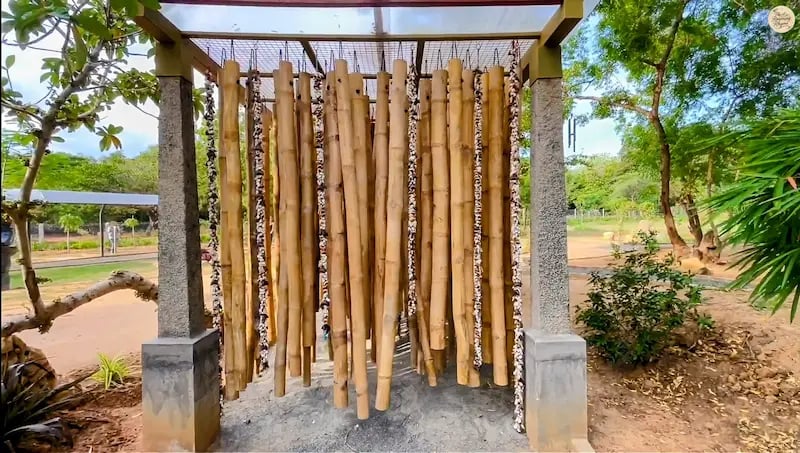


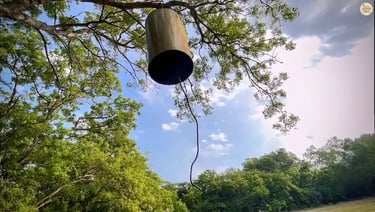
Bamboo sound sculpture at SVARAM Garden.
Large chime bell at Auroville’s SVARAM sound garden.
Café Hopping in Auroville
No visit to Auroville is complete without exploring its charming cafés and bakeries — each with its own character, aroma, and soul. Start with the iconic Auroville Bakery and Boulangerie, a local favorite known for its freshly baked bread, rich dairy items, and divine cheesecakes made from farm-fresh Auroville cheese. Nestled in a lush garden, it’s the perfect spot to sip coffee and let the morning drift by.
Over the years, Auroville has blossomed into an offbeat food haven, thanks to its creative mix of cuisines and conscious dining spaces. The Main Road and nearby market area are dotted with cozy spots, ideal for lingering conversations or a quiet meal after exploring the township.
Stop by Marc’s Café for artisanal brews, The Greek Café for a Mediterranean twist, or Bread and Chocolate Café for sweet indulgence. Craving a hearty meal? Tanto Pizzeria is famous for its wood-fired pizzas, while Ararat Restaurant and Dharma Swasti (a vegan-specialty café) serve wholesome, soulful dishes crafted with care.
Whether you’re a foodie or a wanderer seeking good vibes, Auroville’s café culture is all about slowing down — one cup, one bite, and one easy moment at a time.
Auroville Beach
Wrap up your Auroville visit with a stop at the serene Auroville Beach, a calm stretch of coastline just off the East Coast Road leading into Pondicherry. Known for its soft golden sand with hints of volcanic black, this beach perfectly mirrors the peaceful spirit of the township it’s named after.
Though swimming isn’t recommended due to strong waves, it’s an ideal spot for a quiet walk, meditation, or simply watching the sea shimmer under the sun. Locals and Aurovillians often gather here to unwind, read, or reflect in gentle solitude.
Adding to its natural charm, Auroville Beach also serves as an important nesting site for olive ridley turtles, a beautiful reminder of the quiet coexistence between people and nature that defines Pondicherry’s essence.
Arikamedu Archaeological Site – Ruins, River, and Roman Trade
From the calm of Auroville, drive toward the timeless whispers of Arikamedu, an Ancient Roman Trading Port just a few kilometers from Pondicherry. This quiet archaeological site, nestled along the Ariyankuppam River, once connected India to the vast networks of Rome and Greece.
As you walk through moss-covered ruins and crumbling brick walls, you can almost feel the pulse of history — ships docking, traders bartering, and distant worlds mingling across the waves. Excavations have unearthed Roman amphorae, glassware, coins, beads, and pottery, revealing the vibrant Indo-Roman trade that thrived from the 2nd century BCE to the 8th century CE.
Managed by the Archaeological Survey of India, Arikamedu Pondicherry stands today as a peaceful yet powerful reminder of the region’s global past — a place where history quietly breathes through silence.
#Trivia: Arikamedu is the earliest known Indo-Pacific bead-making site in the world.
Ancient brick ruins of Arikamedu.
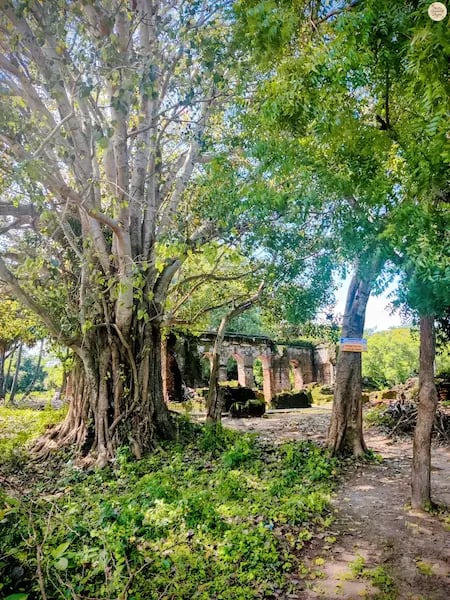

Mangrove Forest Boating – Paddle Through Nature’s Calm
Just a few kilometers from Arikamedu, discover one of Pondicherry’s best-kept secrets — the Mangrove Forest Boating experience. Tucked away on Arikamedu Road, this hidden gem lets you drift through serene waterways wrapped in lush green mangroves — a peaceful world far from the city’s hum.
Hop on a boat or kayak and glide through winding channels as sunlight filters through the canopy above. The still water mirrors the trees, and the air feels thick with calm. Local guides share fascinating stories about the mangrove ecosystem, birds, and marine life that thrive here.
You can also float toward the Thengaithittu Estuary, where the river meets the sea, creating a mesmerizing confluence of fresh and saltwater.
Whether you paddle quietly or simply sit back and drift, this short escape offers a rare, soothing slice of Pondicherry’s natural beauty — one that lingers long after you’ve left the water.
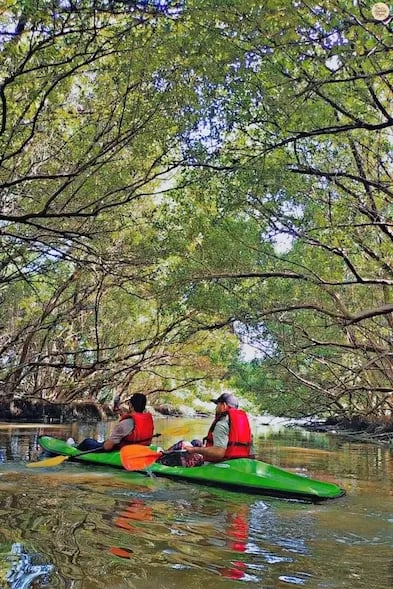



Boat gliding through dense mangroves in Pondicherry.
Kayaking through Pondicherry mangrove forest waterways.
Paradise Beach – The Perfect Finale to Your Pondy Journey
From the ancient charm of Arikamedu, drive about 5 km south to reach the Chunnambar Boathouse, your gateway to Paradise Beach. Hop aboard a ferry gliding through the serene backwaters of the Chunnambar River, with coconut palms swaying on one side and quiet fishing boats on the other — a tranquil ride that feels almost like Kerala’s Alappuzha. In about 20–30 minutes, you’ll arrive at this hidden gem of Pondicherry — also known as Plage Paradiso.
True to its name, the beach is pure bliss — a long stretch of golden sands, swaying palms, and sparkling blue waters where the river meets the Bay of Bengal. The air feels calmer here, the sounds softer — that perfect mix of peace and beauty. Whether you want to take a dip, build sandcastles, or simply sit under a beach hut watching the waves, Paradise Beach Pondicherry lives up to its name.
As the sun begins to set, the beach glows in shades of amber and rose, wrapping up your Pondy exploration on a truly magical note. End the day here — with sandy feet, salty air, and that quiet happiness that only the sea can give.
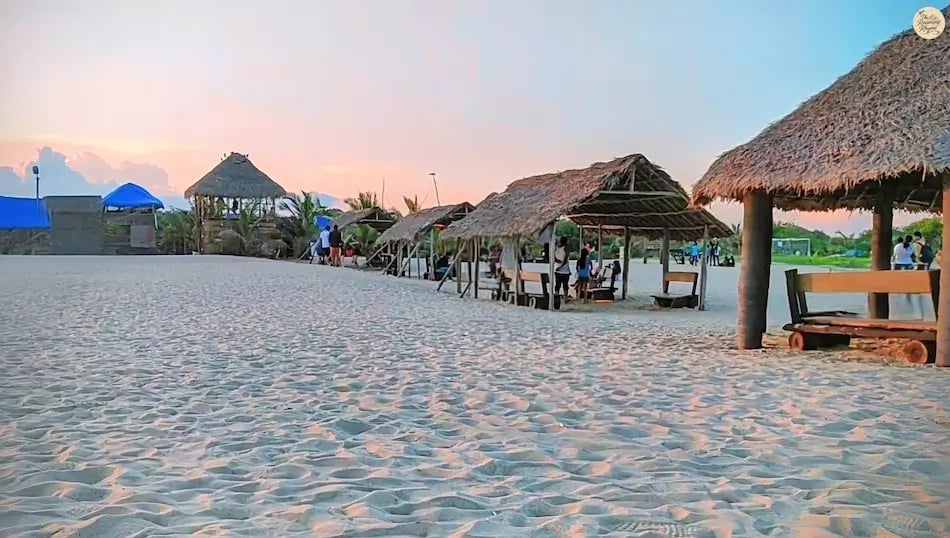

Shacks along the shore at Paradise Beach.
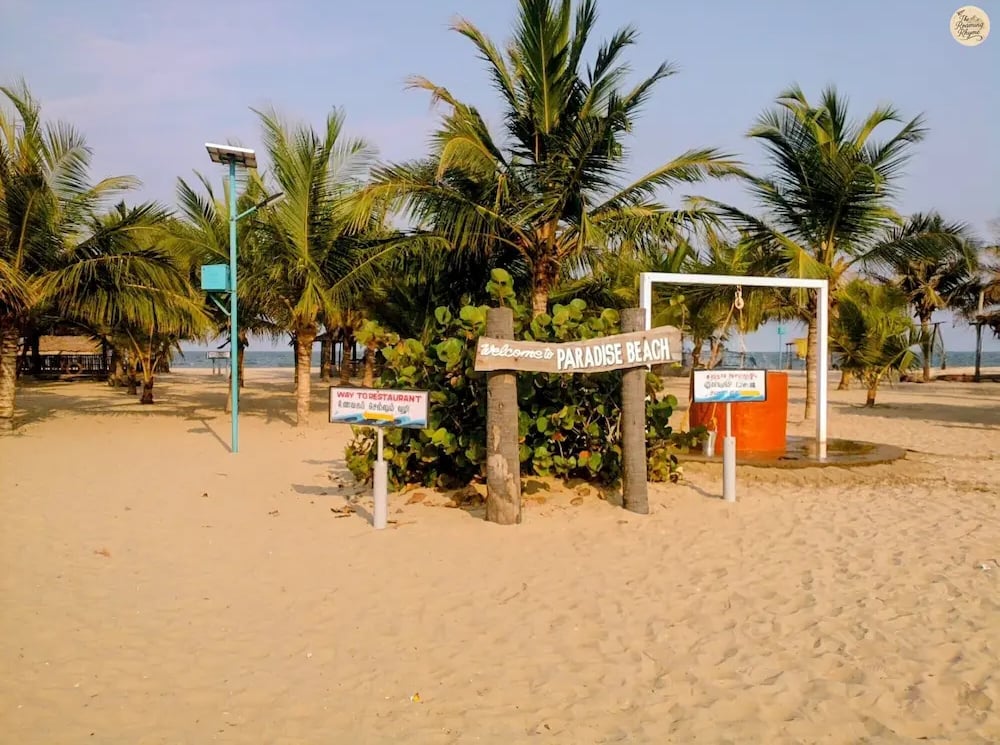

welcome to Paradise Beach — Where the shoreline smiles.
Pondicherry leaves you with a calm that lingers long after you’ve packed your bags. A rocky beach like none other, not far from a white-sand stretch with azure waters; French quarters beside a Dravidian-style temple, mosques and churches standing side by side — a harmony few places can offer.
Designed by the Dutch, coveted by the English, built by the French, and once trading with Rome — this coastal town carries whispers of Mediterranean Europe, its French charm blending beautifully with Indian soul to create something truly unique.
From sunrises that gild the sea to quiet lanes echoing with old-world grace, Pondy moves at its own gentle rhythm. Beyond the town, Auroville’s calm, Arikamedu’s ruins, and Paradise Beach’s golden glow remind you that serenity has many forms.
It’s not just a destination — it’s a feeling. A pause button for the soul, where time slows, hearts soften, and you find yourself in the easy rhythm of the sea. That’s Pondicherry — serene, soulful, and like none other.
Frequently Asked Questions – Pondicherry Travel Guide
Q. What is Pondicherry famous for?
A. Pondicherry, or Puducherry, is famous for its French colonial charm, serene beaches, and spiritual vibes. From the pastel-colored lanes of White Town to the calm aura of Auroville, this coastal gem blends French heritage, Tamil culture, and seaside tranquility beautifully.
Q. What to do at night in Pondicherry?
A. Nightlife in Pondicherry is laid-back yet lively. Take a moonlit stroll along Promenade Beach, sip coffee at heritage cafés, or enjoy a candlelight dinner at a seaside restaurant. For something more upbeat, explore rooftop bars, pubs, or live music spots around White Town.
Q. What clothes to wear in Pondicherry?
A. Light, breathable cotton clothes are perfect for Pondicherry’s tropical weather. Carry comfortable footwear for walking, a hat, and sunglasses for sunny afternoons. If you plan to visit temples, modest attire is appreciated.
Q. Can we roam in Pondicherry on foot?
A. Absolutely! Pondicherry is best explored on foot or by cycle. Walking through White Town’s French quarters, Promenade Beach, and heritage streets lets you soak in the charm, cafés, and vibrant colonial architecture at your own pace.
Q. How many days are good for Pondicherry?
A. A 2-day trip is perfect to experience the essence of Pondicherry — from the heritage charm of White Town and Promenade Beach to the calm energy of Auroville, Arikamedu, and Paradise Beach. If you prefer a slower pace, keep one extra day as a buffer to simply unwind by the sea, linger in cafés, or explore more hidden corners at your own rhythm.
Q. What is Auroville famous for?
A. Auroville, the “City of Dawn,” is famous as a spiritual community promoting human unity, peace, and sustainable living. The Matrimandir, a golden meditation dome, stands at its center — symbolizing inner calm and consciousness.
Q. Is Auroville entry free?
A. Yes, entry to Auroville’s Visitor Centre and surrounding areas is free. To enter the Matrimandir’s inner chamber for meditation, you’ll need prior permission — available only for serious practitioners or by booking ahead.
Q. Can I stay in Auroville for free?
A. Short visits are usually day trips, but volunteer or work-exchange programs sometimes offer stays with basic accommodation. However, free casual stays aren’t available for tourists.
Q. Can Indians stay in Auroville?
A. Yes! Indians and foreigners can both visit and stay in Auroville. Long-term stays are possible through volunteering, internships, or residency programs with prior arrangements.
Q. What to eat in Pondicherry?
A. Pondicherry is a food lover’s paradise, offering a mix of French, Tamil, and global cuisines. Must-try dishes include fresh croissants, Auroville cheese, seafood curries, masala dosas, and wood-fired pizzas. Don’t miss cafés like Baker Street, Bread & Chocolate, and Café des Arts.
Q. Best photography spots in Pondicherry?
A. For the perfect shots, visit White Town’s colorful streets, Promenade Beach, Manakula Vinayagar Temple, Auroville Matrimandir viewpoint, and the Lighthouse. Each corner is a frame-worthy blend of French architecture and coastal beauty.
Q. Most Instagrammable places in Pondicherry?
A. Every lane in Pondy feels made for your feed! Top Instagrammable spots include Rue Surcouf, Matrimandir viewpoint, Paradise Beach, Serenity Beach, and White Town cafés with pastel walls and vintage vibes.
Share Your Thoughts – We’d Love to Hear From You!
Every journey is better when shared.
We hope you enjoyed this travel story — now, we'd love to hear yours! Share your experience, suggestions, or feedback and help us make our travel tales even better.
